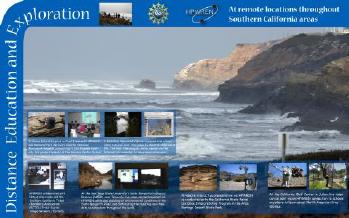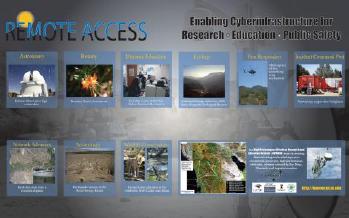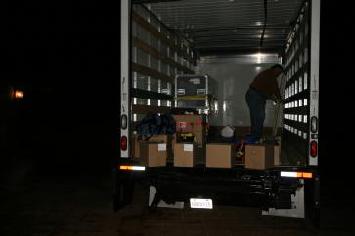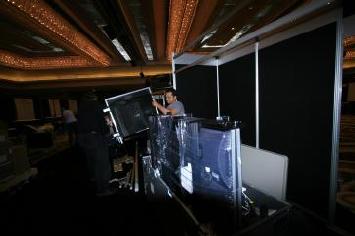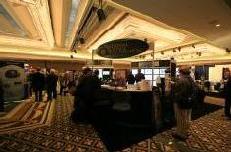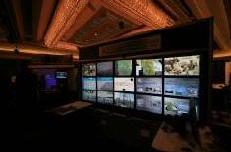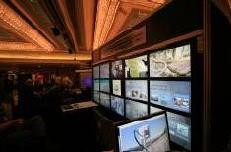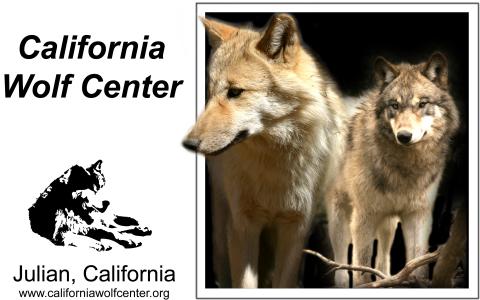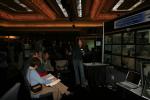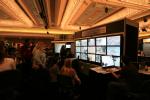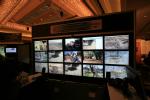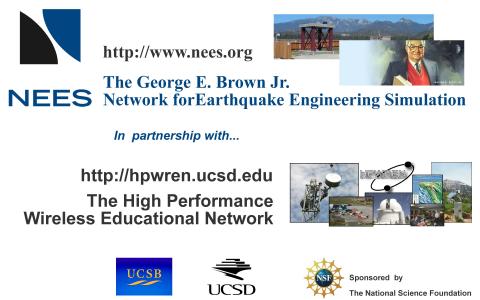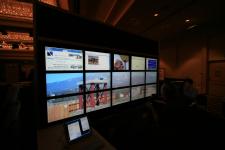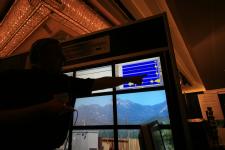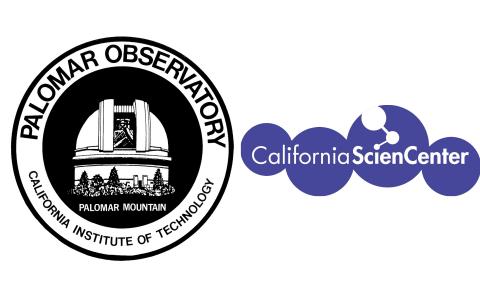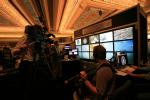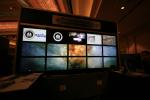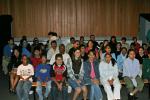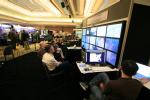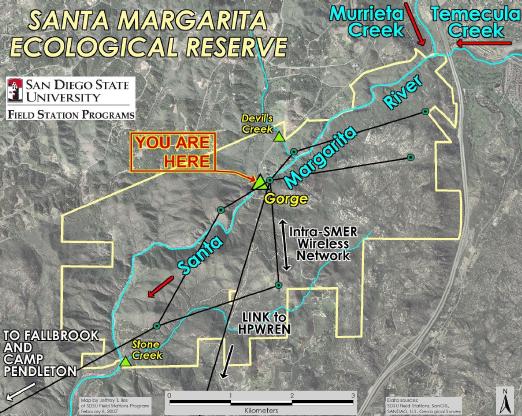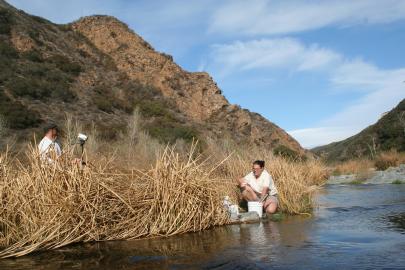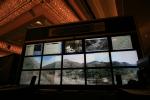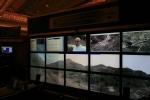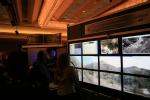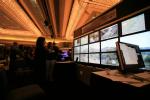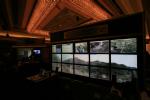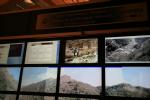|
February 20, 2007
National Science Foundation Exhibit at AAAS 2007 Showcases HPWREN - LIVE
In December 2006 the National Science Foundation, via Kevin
Thompson and Jose Munoz, invited HPWREN to participate
in their exhibit booth at the 2007 American Association for the
Advancement of Science (AAAS) annual meeting in San Francisco, which
lasted from 15-19 February 2007. The objective was to show real-time
cyberinfrastructure enabling research and education activities as
Live Interactive Virtual Explorations (LIVE) of remote science
sites. The overall exhibit coordination was led by Susan Mason
of the NSF while HPWREN Principal Investigator Hans-Werner
Braun coordinated the HPWREN-specific activities.
The activity was fairly involved, and this summary describes the
combined efforts of more than 30 people, who helped make the events
successful.
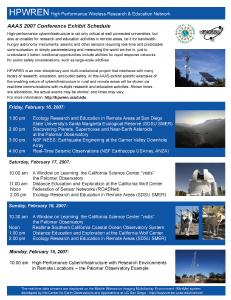
|
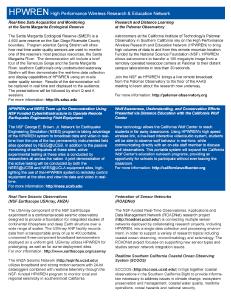
|
Monika Braun produced several pieces of artwork for the
HPWREN portion of the NSF booth at the AAAS 2007 exhibit,
including a banner (above), a handout (left),
four-screen distance education and overview posters (below),
and a California Wolf Center display (later in this article).
|
Kimberly Mann Bruch provided a schedule
summary and media advisory, working with Leslie Fink of the
National Science Foundation.
Of significant help was that HPWREN Co-Principal Investigator
Frank Vernon obtained permission from John Orcutt to
utilize the Mobile
INteractive Imaging Multidisplay Environment, developed by the
Center for Earth Observation and Applications at UC San Diego. CEOA
also allowed Atul Nayak and Thomas Im to prepare for
and support the 15-screen display on site during the conference
exhibit.
|
Jim Hale took responsibility for trucking the equipment from San
Diego to San Francisco (left), and participated in the
installation (right, with Atul Nayak). During the conference
Jim Hale returned to San Diego to support the network, as well as
conference presentations via HPWREN.
|
|
HPWREN display at the NSF booth showing the reception view
(left), and the display during non-real-time events
(middle). The view to the right depicts a time
lapse animation of the San Diego "Horse Fire," narrated by
retired CDF Captain Ron Serabia. Producing the higher
resolution 1024x768 size animation with its sound track was
possible due to help from Daniel Hoffmann and Yvonne
Clasbrummel.
|
Several Live Interactive Virtual Exploration events were shown
across the conference dates, and each kind is featured below. Many
of the real-time audio/video connections used Skype with an attached
digital video camcorder via firewire, and demonstrated an inexpensive
way for field researchers to communicate. The audio/video connections
with the Palomar Observatory used Polycom ViewStation FX equipment
at the conference and the Observatory, and an HPWREN Polycom v500
at the California Science Center. However, the brand new Polycom
v500 worked on Saturday, but consistently failed on Sunday, making
it the only LIVE event that (at least partly) failed for the AAAS
2007.
LIVE events: California Wolf Center
|
Melinda Booth moderated the California Wolf Center LIVE
session from the conference exhibit, while communicating
with Patrick Valentino (on Saturday) and Kimberly
Miller (on Sunday) in the wolf enclosures at the CWC.
|
LIVE event: UC Santa Barbara's Garner Valley Downhole Array
NEES site
|
Hank Ratzesberger (right top photo) is supporting Jamison
Steidl and Robert Nigbor as they demonstrate the
capabilities of the remotely controlled shaker mounted on the
experimental structure located at the Garner Valley field site,
with Frank Vernon and Thomas Im seen at the
conference floor. In the bottom image, Frank Vernon, is
shown moderating the demonstration from San Francisco. He had
initiated the shaker excitation and is pointing out the resulting
motions of the structure on the waveform display.
UC Santa Barbara has posted an own writeup about the event at
http://nees.ucsb.edu/outreach/2007AAAS/.
|
LIVE events: Palomar Observatory and California Science Center
|
The Palomar Observatory events were supported by Andrew
Pickles and Bob Thicksten of the California Institute
of Technology. Benjamin Weaver (top right photo), member
of Greg Aldering's Nearby Supernova Factory research group
at the Lawrence Berkeley Laboratory, is presenting in front of
an NSF camera team. In the second image Scott Kardel is
presenting to a classroom at the California Science Center,
organized by Chuck Kopczak and Kim Burtnyk, with
the class shown in the third photo. The bottom photo shows
Daniel Zieber explaining the complexities of the observatory's
data infrastructure, and why real-time communication is important
to astronomy research.
|
LIVE events: San Diego State University's Santa Margarita
Ecological Reserve
|
San Diego State University's Santa Margartia Ecological Reserve
event was supported by Matt Rahn, with Spring Strahm
(top left photo) presenting from SMER, and Pablo Bryant
(second from top) making it all work. The third photo shows
Morgan Robertson of the National Park Service's California
Mediterranean Research Learning Center moderating the event
from San Francisco, with Jose Munoz and Thomas Im
watching. In the forth photo Susan Mason is communicating
with Spring Strahm. The fifth and sixth photo shows
NPS/CMRLC's Susan Teel (Saturday), and NPS Rangers
Patricia Heusner and Volunteer Laura Congdon (Sunday)
helping. The photo on the bottom left shows Spring Strahm
and Pablo Bryant at the SMER site during one of the
presentations. LIVE activities included real-time audio/video
with Spring Strahm as the field researcher, time-series graphs
of the river chemistry data that were updated about once per minute,
a higher-elevation three megapixel camera updating its image
every few seconds, and a 22+ megapixel three-camera
180-degree panorama that was updated every few minutes.
|
LIVE events: Seismology research, sensor networks, and ocean
observing
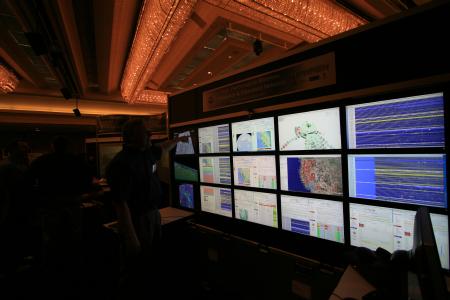
|
Frank Vernon is presenting on real-time seismic
observations (NSF Earthscope USArray and ANZA). In separate
presentations he focused on a federation of sensor networks
(ROADnet) and the Realtime Southern California Coastal Ocean
Observing Syatem (SCCOOS).
|
Many more photos are available at
/Photos/20070219.AAASPhotos/.
 back to top
back to top
 back to HPWREN news
back to HPWREN news |




